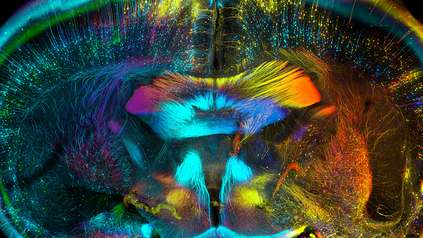New drug targets for lethal brain cancer discovered
More than 200 genes with novel and known roles in glioblastoma – the most aggressive type of brain cancer – offer promising new drug targets. Researchers from the Wellcome Sanger Institute, Addenbrooke’s Hospital and their collaborators engineered a new mouse model to show for the first time how a mutation in the well-known cancer gene, EGFR initiates glioblastoma, and works with a selection from more than 200 other genes to drive the cancer.
The results, published today (30 July) in Genome Biology present the first mouse model of its kind, which is available for the research community to advance new treatments for this lethal form of brain cancer.
Glioblastoma is an aggressive form of brain cancer. It is treated with surgery followed by chemotherapy or radiotherapy, however glioblastoma cells can evade treatment and tumours return. The prognosis is poor – the average patient survives for 12-18 months following diagnosis*.
New, targeted treatments and immunotherapies are currently being developed to help glioblastoma patients. It is still not known exactly why glioblastomas begin to grow.
In a new study, researchers from the Wellcome Sanger Institute and their collaborators created a new mouse model with glioblastoma to investigate which genes were implicated in the cancer.
The model showed that the well-known cancer gene, EGFR (epidermal growth factor receptor) can alone initiate the brain tumours to grow in mice, resulting in tumours that were highly representative of human glioblastomas.
“We have created a new mouse model for studying the lethal human brain cancer, glioblastoma. For the first time, we showed that the familiar cancer gene, EGFR is capable of initiating glioblastoma and we identified new driver genes, whose potential for therapeutic targeting deserves further exploration.”
Dr Imran Noorani corresponding author previously from the Wellcome Sanger Institute, and now based at Addenbrooke’s Hospital and the University of Cambridge
To identify which genes help EGFR to drive the cancer, the team used the PiggyBac transposon technique – a small section of DNA inserted into different parts of the genome to introduce mutations. This revealed more than 200 known and novel mutations in tumour suppressor genes that were working with EGFR to drive brain tumour growth, many of which present new drug targets.
The team compared the results with human genome sequences from glioblastoma patients and uncovered many genetic mutations found in both humans and mice. Human genomic data contains many mutations implicated in glioblastoma, without clear indication of which specific mutations drive the cancer. With the new mouse model, the team were able to narrow down on which mutations drive glioblastoma, which will focus future drug development.
“Glioblastoma patients urgently require new, targeted therapies. Unfortunately, glioblastoma tumours can become highly resistant to therapies that target specific molecules, as there are many other genetic drivers that can ‘take over’ progressing the cancer. This new mouse model provides the missing link to translate findings from new potential treatments tested on mice to clinical trials.”
Professor Allan Bradley previously Director of the Wellcome Sanger Institute, and now Chief Scientific Officer of Kymab and Professor in the Department of Medicine, University of Cambridge
More information
*For more information on glioblastoma, visit The Brain Tumour Charity
Publication:
Imran Noorani et al. (2020) PiggyBac mutagenesis and exome sequencing identify genetic driver landscapes and potential therapeutic targets of EGFR-mutant gliomas. Genome Biology. DOI: 10.1186/s13059-020-02092-2
Funding:
This work was supported by Wellcome grant 098051.
Selected websites
The University of Cambridge
The mission of the University of Cambridge is to contribute to society through the pursuit of education, learning and research at the highest international levels of excellence. To date, 107 affiliates of the University have won the Nobel Prize.
Founded in 1209, the University comprises 31 autonomous Colleges, which admit undergraduates and provide small-group tuition, and 150 departments, faculties and institutions. Cambridge is a global university. Its 19,000 student body includes 3,700 international students from 120 countries. Cambridge researchers collaborate with colleagues worldwide, and the University has established larger-scale partnerships in Asia, Africa and America.
The University sits at the heart of the ‘Cambridge cluster’, which employs 60,000 people and has in excess of £12 billion in turnover generated annually by the 4,700 knowledge-intensive firms in and around the city. The city publishes 341 patents per 100,000 residents.Kymab
Based in Cambridge, UK, we are a clinical-stage biopharmaceutical company developing a deep pipeline of novel human antibody-based therapies in a broad range of indications. Our unique platforms generate a vast repertoire of fully-human, species cross-reactive and affinity-matured antibodies against challenging targets.
Wellcome Sanger Institute
The Wellcome Sanger Institute is a world leading genomics research centre. We undertake large-scale research that forms the foundations of knowledge in biology and medicine. We are open and collaborative; our data, results, tools and technologies are shared across the globe to advance science. Our ambition is vast – we take on projects that are not possible anywhere else. We use the power of genome sequencing to understand and harness the information in DNA. Funded by Wellcome, we have the freedom and support to push the boundaries of genomics. Our findings are used to improve health and to understand life on Earth. Find out more at www.sanger.ac.uk or follow us on Twitter, Facebook, LinkedIn and on our Blog.
Wellcome
Wellcome exists to improve health by helping great ideas to thrive. We support researchers, we take on big health challenges, we campaign for better science, and we help everyone get involved with science and health research. We are a politically and financially independent foundation.



